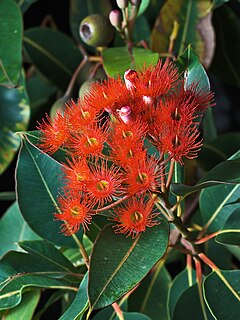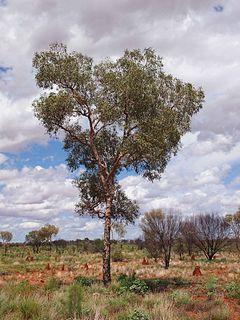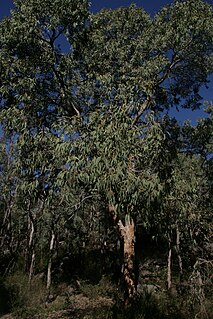
Corymbia is a genus of about 113 species of tree that were classified as Eucalyptus species until the mid-1990s. It includes the bloodwoods, ghost gums and spotted gums. The bloodwoods had been recognised as a distinct group within the large and diverse genus Eucalyptus since 1867. Molecular research in the 1990s, however, showed that they, along with the rest of the section Corymbia, are more closely related to Angophora than to Eucalyptus, and are probably best regarded as a separate genus. All three genera—Angophora, Corymbia and Eucalyptus—are closely related, often difficult to tell apart, and are still commonly and correctly referred to as "eucalypts". Groups of naturalists and conservationists do not recognise the genus Corymbia and still categorise its species within Eucalyptus.

Corymbia ficifolia, commonly known as the red flowering gum, Albany red flowering gum and the Albany redgum, is one of the most commonly planted ornamental trees in the broader eucalyptus family. The species was previously known as Eucalyptus ficifolia until re-classified in 1995.

Rosewood refers to any of a number of richly hued timbers, often brownish with darker veining, but found in many different hues.

Corymbia calophylla is a species of tree, common in the southwest of Australia. Originally described as a species of Eucalyptus, it is commonly named as marri in preference to red gum.

Pterocarpus angolensis is a species of Pterocarpus native to southern Africa, in Angola, Mozambique, Namibia, South Africa, Swaziland, Tanzania, Zaire, Zimbabwe,and Zambia. It is a protected tree in South Africa. The name Kiaat, although Afrikaans, is sometimes used outside South Africa as well. In Zimbabwe, depending on what region you are in, it is known as Mukwa or Mubvamaropa.
Corymbia abergiana, commonly known as range bloodwood or Rockingham Bay bloodwood, is a bloodwood native to Queensland, Australia.

Corymbia intermedia or the pink bloodwood is a bloodwood native to Queensland and New South Wales. More specifically it is found on a narrow belt ranging from Cooktown to north of Newcastle.

Corymbia aparrerinja commonly known as ghost gum, is an evergreen tree that is native to Central Australia.

Kino is a botanical gum produced by various trees and other plants, particularly bloodwood species of eucalypts and Pterocarpus, in reaction to mechanical damage, and which can be tapped by incisions made in the trunk or stalk. Its mostly red colour, together with the tendency of some species to ooze large amounts of it from wounds, is the source of the common names "red gum" and "bloodwood". The word kino is of Indian origin. In Australia, "red gum" is a term for kino from bloodwood trees and red acaroid resin from Xanthorrhoea spp.

Corymbia opaca, also known as the desert bloodwood, is a tree native to Australia. The tree is most well known for the distinctive red kino that it exudes. Australian Aboriginal people collect bush coconuts from the tree, which are produced by an insect in gall.

Corymbia terminalis, also known as tjuta, joolta, bloodwood, desert bloodwood, plains bloodwood, northern bloodwood, western bloodwood or the inland bloodwood, is a tree native to Australia.

Corymbia eximia, commonly known as the yellow bloodwood, is a bloodwood native to New South Wales. It occurs around the Sydney Basin often in high rainfall areas on shallow sandstone soils on plateaux or escarpments, in fire prone areas. Growing as a gnarled tree to 20 m (66 ft), it is recognisable by its distinctive yellow-brown tessellated bark. The greyish green leaves are thick and veiny, and lanceolate spear- or sickle-shaped. The cream flowerheads grow in panicles in groups of seven and appear in spring. Known for many years as Eucalyptus eximia, the yellow bloodwood was transferred into the new genus Corymbia in 1995 when it was erected by Ken Hill and Lawrie Johnson. It is still seen under the earlier name in some works.
Corymbia papuana, formerly known as Eucalyptus papuana, is an evergreen tree native to New Guinea and northern Australia.
Corymbia haematoxylon, formerly known as Eucalyptus haematoxylon, is a species of eucalypt native to southwestern Australia. It was given its current name in 1995 with the creation of the genus Corymbia. Common names include lesser bloodwood and mountain marri. The tree is associated with Corymbia calophylla (marri) woodland and resembles a miniature version of it,.
Corymbia zygophylla, commonly known as the Broome bloodwood, is a species of plant in the myrtle family that is native to northern Western Australia.

Corymbia erythrophloia, commonly known as the variable-barked bloodwood, the red-barked bloodwood, the gum-topped bloodwood or the red bloodwood, is a bloodwood native to Queensland, Australia.
Corymbia jacobsiana, commonly known as Jacob's bloodwood or the stringybark bloodwood, is a member of the Corymbia genus, it is native to the Northern Territory

Corymbia setosa, commonly known as the rough leaved bloodwood and the rough leaved range gum, is a member of the genus Corymbia native to northern Australia.
Corymbia sphaerica, commonly known as the big-fruited bloodwood, is a member of the Corymbia genus native to the Northern Territory.

















